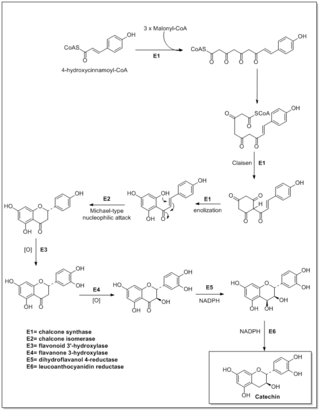
Buckwheat or common buckwheat is a flowering plant in the knotweed family Polygonaceae cultivated for its grain-like seeds and as a cover crop. Buckwheat originated around the 6th millennium BCE in the region of what is now Yunnan Province in southwestern China. The name "buckwheat" is used for several other species, such as Fagopyrum tataricum, a domesticated food plant raised in Asia.

Fagopyrum tataricum, also known as Tartary buckwheat, green buckwheat, ku qiao, Tatar buckwheat, or bitter buckwheat, is a domesticated food plant in the genus Fagopyrum in the family Polygonaceae. With another species in the same genus, common buckwheat, it is often counted as a cereal, but the buckwheats are not closely related to true cereals.

Ferulic acid is a hydroxycinnamic acid; it is an organic compound with the formula (CH3O)HOC6H3CH=CHCO2H. The name is derived from the genus Ferula, referring to the giant fennel (Ferula communis). Classified as a phenolic phytochemical, ferulic acid is an amber colored solid. Esters of ferulic acid are found in plant cell walls, covalently bonded to hemicellulose such as arabinoxylans. Salts and esters derived from ferulic acid are called ferulates.

Rutin is the glycoside combining the flavonol quercetin and the disaccharide rutinose. It is a flavonoid glycoside found in a wide variety of plants, including citrus.

Phyllostachys nigra, commonly known as black bamboo or purple bamboo, is a species of bamboo, native to Hunan Province of China, and is widely cultivated elsewhere.

2-Nonenal is an unsaturated aldehyde. The colorless liquid is an important aroma component of aged beer and buckwheat and insoluble in water.

Olive leaf is the leaf of the olive tree. Although olive oil is well known for its flavor and possible health benefits, the leaf and its extracts remain under preliminary research with unknown effects on human health.

Flavonoids are synthesized by the phenylpropanoid metabolic pathway in which the amino acid phenylalanine is used to produce 4-coumaroyl-CoA. This can be combined with malonyl-CoA to yield the true backbone of flavonoids, a group of compounds called chalcones, which contain two phenyl rings. Conjugate ring-closure of chalcones results in the familiar form of flavonoids, the three-ringed structure of a flavone. The metabolic pathway continues through a series of enzymatic modifications to yield flavanones → dihydroflavonols → anthocyanins. Along this pathway, many products can be formed, including the flavonols, flavan-3-ols, proanthocyanidins (tannins) and a host of other various polyphenolics.

Vitexin is an apigenin flavone glucoside, a chemical compound found in the passion flower, Vitex agnus-castus, in the Phyllostachys nigra bamboo leaves, in the pearl millet, and in Hawthorn.

Isoorientin is a flavone, a chemical flavonoid-like compound. It is the luteolin-6-C-glucoside. Bioassay-directed fractionation techniques led to isolation of isoorientin as the main hypoglycaemic component in Gentiana olivieri. Studies also showed that isoorientin is a potential neuroprotective compound against Alzheimer's disease.

Cynaroside is a flavone, a flavonoid-like chemical compound. It is a 7-O-glucoside of luteolin.
The pyranoanthocyanins are a type of pyranoflavonoids. They are chemical compounds formed in red wines by yeast during fermentation processes or during controlled oxygenation processes during the aging of wine. The different classes of pyranoanthocyanins are carboxypyranoanthocyanins, methylpyranoanthocyanins, pyranoanthocyanin-flavanols, pyranoanthocyanin-phenols, portisins, oxovitisins and pyranoanthocyanin dimers; their general structure includes an additional ring that may have different substituents linked directly at C-10.

Curculigosides are phenols that have been isolated from a variety of plant sources. Curculigoside A, B, C and D can be found in Curculigo orchioides. Curculigoside B can be isolated by high-speed counter-current chromatography. Curculigosides B and D have in vitro activity against β-amyloid aggregation.

Pteris ensiformis, the slender brake, silver lace fern, sword brake fern, or slender brake fern, is a plant species of the genus Pteris in the family Pteridaceae. It is found in Asia and the Pacific.

Sanguiin H-6 is an ellagitannin.

p-Coumaric acid glucoside is a hydroxycinnamic acid, an organic compound found in commercial breads containing flaxseed.

Catechin-7-O-glucoside is a flavan-3-ol glycoside formed from catechin.

Liquiritin is the 4'-O-glucoside of the flavanone liquiritigenin. Liquiritin is one of flavone compounds derived from licorice.

Ideain, the cyanidin 3-O-galactoside, is an anthocyanin, a type of plant pigment.

Phlomoides tuberosa, the sage-leaf mullein, is a perennial herbaceous flowering plant in the family Lamiaceae, native to China, Kazakhstan, Kyrgyzstan, Mongolia, Russia; SW Asia and Europe. Enlarged, tuberous roots give rise to erect stems to 150 cm bearing purple-red flowers.



















